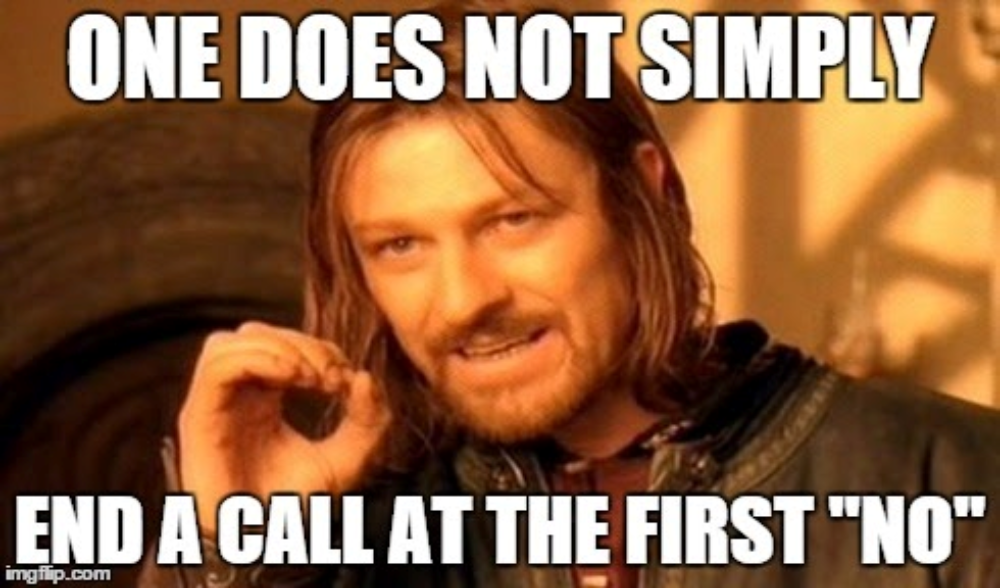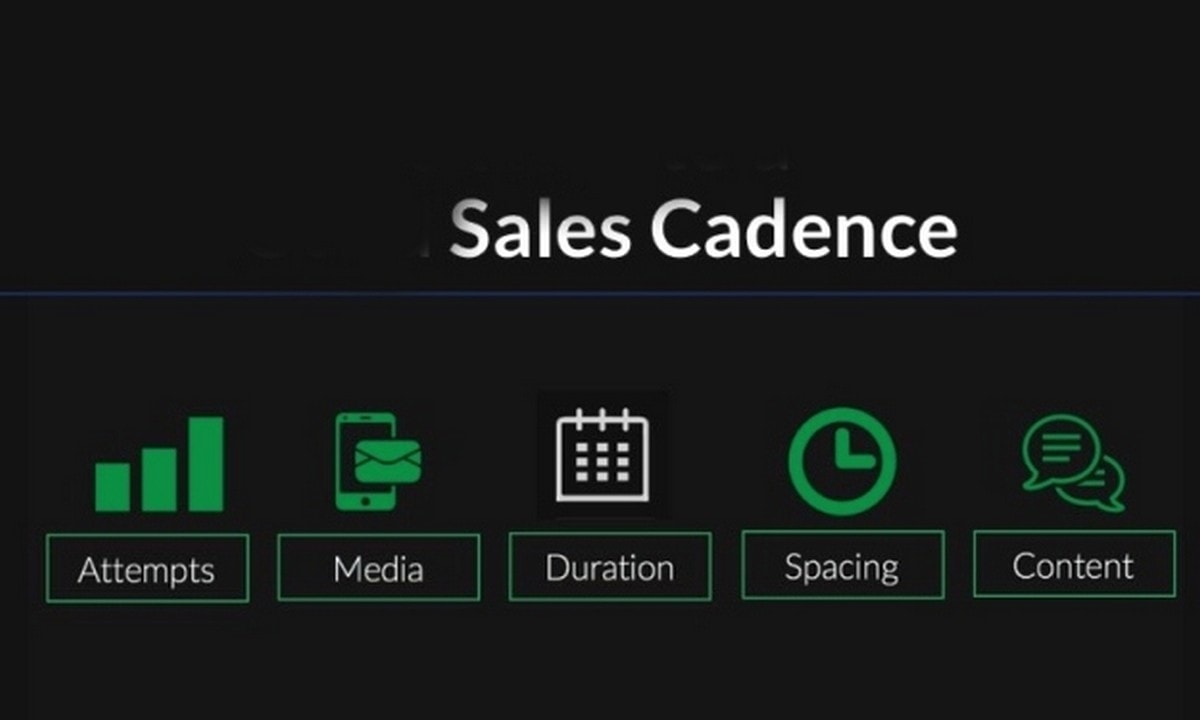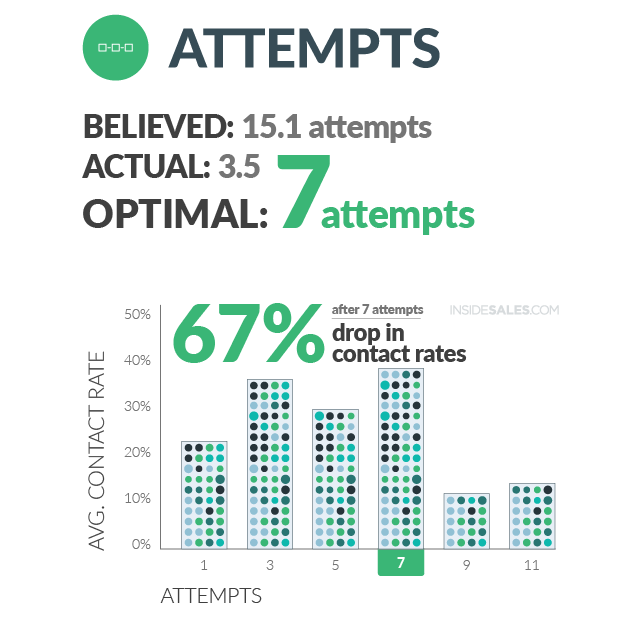Sales Cadence on Your Mind? Here Are 4 Useful Examples That Could Work
Remember the knots in your stomach when you asked that “special someone” to prom? The clammy palms and cotton-dry mouth may make a reappearance years later when you are approaching a prospect as a sales representative. After all, the stakes are about the same.

Given that even the best reps require an average of eight touches before pulling the trigger on their sales pitch, it can feel overwhelming, no doubt. And so, it may come as a respite that a little pre-planning can offset these awful emotions and make you a smooth player while handling interactions. The trick lies in maintaining a reliable sales cadence that works for you.

But what is sales cadence in the first place? And how can you harness it as a powerful tool to meet your sales targets? Let’s take a look.
What Is Sales Cadence?
Traditionally, cadence relates to a rhythm or a tempo.
Along the same lines, sales cadence is about creating a periodic and repeatable series of activities. These will be a strategy to increase contacts and qualify prospects, thereby acting as a roadmap to successful sales.
Think of it as the beat to which your sales teams dance – an art and a science that requires an understanding of the human psyche and leveraging it to drive conversions.

Sales cadence could be inbound or outbound. The former is when you contact a prospect who knows about your company. Conversely, outbound cadence is when the salesperson reaches out to contact someone who does not know your company in any way.
Despite this blanket definition, there is clearly a lot going on under the hood, which makes sales cadence crucial for success.
But what constitutes a foolproof sales cadence? Let’s find out.
Elements of a Successful Sales Cadence
One may view sales cadence as the number of attempts of contact per lead. But that would be a highly simplified way. In contrast, sales cadence is as layered and complex as a well-cooked lasagna, bearing several elements to it.

The primary elements of a successful sales cadence include:
Attempts
Attempts are the total number of touches made with a lead or a contact.

According to an InsideSales.com survey of 1000 companies, the total number of reported touches was 15.4, which can be broken down into 4.7 calls, 4.6 emails, 2.9 voicemails, 1.8 social touches, 0.8 mailers, and 0.7 text messages. However, the total number of attempts lingered at 3 to 4.05.
While some salespersons may swear by the magic number between 8 and 10, these are purely arbitrary. Ultimately, it is all about trying and testing to discover what works for you.
Media
Next, we have the different media formats that are deployed to reel in the leads or prospects. The commonest channels for prospecting include phone calls, text messaging, voicemails, emails, videos, social media, and direct media.
Typically, a diverse set of outreach channels generate a better response than sticking to a single-mode. For instance, a single communication method has a 9.5% of success rate while three communication methods can drive it up to 25.1%, which, needless to say, is phenomenal.
Further, one needs to get creative with their campaigns to maintain a competitive edge. Of late, social media and videos are gaining traction as they present a host of advantages.
Duration

Duration is the time elapsed between the first contact and the last attempt. Ideally, it is best to maintain a duration of 6 to 8 days for optimal results. Anything beyond that would put a cap on your abilities with the law of diminishing returns and render your efforts unfruitful.
Spacing

Spacing relates to the time between activities. It is essentially your perception of the periodicity to follow so that you don’t bug your prospects or scare them away. The optimal spacing is ideally 2 days to finetune the dial between “forgettable” and “annoying.”
Content

Content comprises the messaging used in your sales cadence. It is the tool for initiating contact or educating your prospect. As such, the content in your email, video, text messages, or voicemails could be the determining factor to hook your customers.
Ideally, it is best to limit your prospecting email to 300 words, voice messages within 30 seconds, and videos between 60 to 90 seconds for a lasting impact.
As buyers have started taking over the sales process, a fresh element is now making its way into the ideal sales cadence – Buyer’s Persona. Buyer’s Persona encourages companies to research their target audience so that they can personalize the customer journey and experience through techniques like segmentation.

Now that you have an in-depth understanding of everything surrounding sales cadence, use it as a frame of reference as we take a look at a few practical sales cadence examples that you can implement.
Sales Cadence Example 1: The Email-Call-Voicemail Trinity
If you have a lengthy sales process (think SaaS, consulting, insurance, etc.), then this sales cadence will match up to your requirements. It is spread across 77 days and involves approximately 25 touchpoints.
Structure
The structure of this sales cadence goes something like this:
- Day 1: Email 1
- Day 2: Call 1, Voice mail 1, Email 2
- Day 7: Call 2, Voice mail 2, Email 3
- Day 14: Call 3, Voice mail 3, Email 4
- Day 21: Call 4, Voice mail 4, Email 5
- Day 35: Call 5, Voice mail 5, Email 6
- Day 49: Call 6, Voice mail 6, Email 7
- Day 63: Call 7, Voice mail 7, Email 8
- Day 77: Call 8, Voice mail 8, Email 9

Pros
- It has an excellent start with a cold email outreach followed by a call on day two.
- It combines synchronous and asynchronous forms for communications.
- Even though voicemail may appear to be an obsolete channel, this sales cadence makes smart use of it to maintain contact.
Cons
- The lack of a social media component can be a setback, given the modern built-in requirements for the same.
- The successive touchpoints may be spaced out by a greater degree from each other, which may cause a loss in engagement by offsetting the immediacy.
- It primarily relies on a limited number of channels of communication in a repetitive and predictable pattern.
- The 77-day long drip campaign is not only extensive but can be a drain on precious resources.
Sales Cadence Example 2: The Email, Call, Voicemail, Social Media Quadruple
If your outbound sales strategy aims to leave behind a maximum impact in the shortest possible time of 5 days, then this sales cadence can be suited for fast-paced action where urgency is the primary driving force.
Structure
The structure of this sales cadence goes something like this:
- Day 1: Emails 1 and 2
- Day 2: Email 3
- Day 3: Call 1, Voice Mail 1
- Day 4: Social Media 1, Email 4
- Day 5: Call 2, Email 5, Social Media 2
Pros
- It harnesses three main channels of email, phone, and social media to connect with prospects.
- Emails carry maximum weightage in the correspondences, which maintains a sense of professionalism.
- It breaks apart from the monotony and mixes up the number of channels for different touchpoints on the same day.
Cons
- The flurry of activities within a short span can cause the prospect to feel overwhelmed.
- You have to wait until the third day since the opening of the mail to schedule a call. Plus, the occurrence of phone calls is too infrequent.
- The number of touchpoints (10) can be considered low for transactional businesses.
Sales Cadence Example 3: The Email-Phone Alternator
This 22-day sales cadence alternates between emails and phone calls to deliver consistent, tried-and-tested results. It entails 13 touchpoints, primarily in the form of email and phone calls.
Structure
The structure for this sales cadence goes something like this:
- Day 1: Email
- Day 3: Phone
- Day 4: Email
- Day 7: Phone
- Day 7 Email
- Day 10: Phone
- Day 12: Email
- Day 14: Phone
- Day 16: Email
- Day 19: Phone
- Day 21: Phone and Email
- Day 22: Nurture or Repeat
Pros
- The three-week period can be a perfect balance of staying on top of your prospect’s mind and giving them space.
- It leverages immediacy and nudges action without coming off as aggressive.
Cons
- The channels are limited to phones and emails, which limits its potential.
- The follow-up call is put on hold for two days until the email is opened, which can be an inordinate delay.
- It fails to maximize per day engagement as it only deploys a single-channel outreach per day.
Sales Cadence Example 4: The Omnichannel Approach
The major flaw with the sales cadence examples discussed so far is that they rely too heavily on a maximum of two to three channels. In contrast, this sales cadence example utilizes a mix of channels to connect with the prospect and help them gently nudge them through the sales funnel.
Structure
The structure for this sales cadence goes something like this:
- Day 1: Prospect research over social media or digital trail.
- Day 2: InMail message introducing yourself and your business.
- Day 3: Follow-up InMail as a nudge and to collect information.
- Day 4: Email to initiate a conversation over email.
- Day 5: “Yet to Hear From You” Follow-up Email
- Day 6: Phone to warm the cold outreach and to collect pain points.
- Day 7: Sharing articles or tagging the prospect on helpful social media posts.
- Day 8: Emails with video attachments to further break the ice.
- Day 9: Engage prospects on social media like LinkedIn.
- Day 10: Call to book an appointment. If your call goes unanswered, leave a voicemail requesting a callback.
- Day 11: Email to work out the details and the schedule for the appointment.
- Day 12: Phone or Email to confirm the appointment.
Pros
- The campaign takes 12 to 22 days, which is ideal for maintaining peak engagement.
- It intersperses every touchpoint with a blend of channels – be it email, phone, or social media.
- The use of rich media content adds value to every touchpoint and makes it more meaningful.
- It hits the sweet spot between sustained, result-oriented persistence and annoying, off-putting disturbance.
Cons
- It requires thorough planning and research to incorporate elements such as personalization.
- You will have to depend on digital tools such as a CRM to maintain scalability in outreach.
FAQs
-
Q.1. What are the benefits associated with sales cadence?
Sales cadence grants the following benefits to businesses and sales reps alike:
Enforces a structured framework for contacting and following up prospects.
Eliminates guesswork and introduces a standardized tried-and-tested approach.
Maintains consistency regardless of the sales representative.
Helps leads move through the different stages of the sales funnel.
In a nutshell:
Source -
Q.2. How can you measure the response to your sales cadence?
Track the following KPIs to measure the performance of your existing sales cadence:
Email open and click rate: If your email is being opened, it means that your subject line has managed to capture the receiver’s interest. If they click on the link embedded in an email, it signifies that the contents of the email have prompted action.
Email open to reply ratio: If your emails are receiving responses, it means that your content resonates with the audience.
Call to appointments ratio: The number of calls required to book an appointment lends insights into whether you are targeting according to your buyer’s persona.
Bounce rate: This is a reflection of your mailing list. Maintaining the hygiene of your mailing list will reduce bounce rates. -
Q.3 How can you improve your sales cadence?
Here are some tricks to perfecting your sales cadence:
Source
Okay, for real, though – here's what you need to do:
Find the best times for calling or emailing your prospect, depending on the industry.
Stay persistent but avoid going into the “clingy” territory.
Target your audience with the right form of content.
Maintain quality and quantity while performing outreach.
Test and optimize your sales cadence and make adjustments as per results.
While being proactive, seek explicit consent from your prospect and ask for their preferred mode of communication.
Conclusion
Amongst all the examples seen so far, the omnichannel sales cadence makes the most sense in the present scenario. It maintains high engagement rates and times every touchpoint to make it meaningful. Use the above guide and pointers to build a sales cadence that works for YOU. You decide what works based on the pros and cons listed for each example. Understand your industry nature, sales process, and tech stack to devise the right cadence, which will set you on the path of imminent success.

